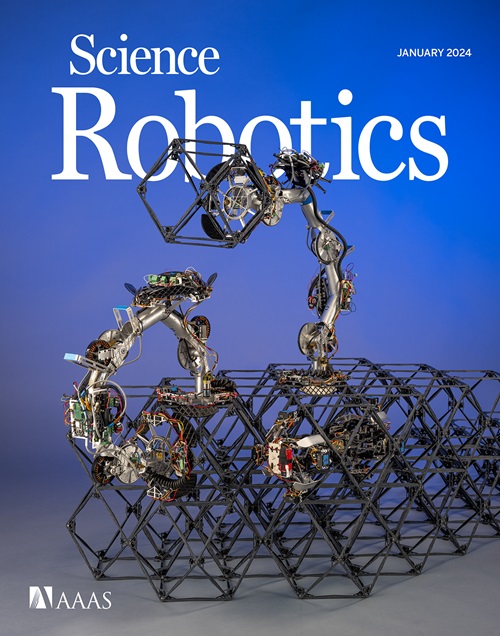EELS: Autonomous snake-like robot with task and motion planning capabilities for ice world exploration
IF 27.5
1区 计算机科学
Q1 ROBOTICS
引用次数: 0
Abstract
Ice worlds are at the forefront of astrobiological interest because of the evidence of subsurface oceans. Enceladus in particular is unique among the icy moons because there are known vent systems that are likely connected to a subsurface ocean, through which the ocean water is ejected to space. An existing study has shown that sending small robots into the vents and directly sampling the ocean water is likely possible. To enable such a mission, NASA’s Jet Propulsion Laboratory is developing a snake-like robot called Exobiology Extant Life Surveyor (EELS) that can navigate Enceladus’ extreme surface and descend an erupting vent to capture unaltered liquid samples and potentially reach the ocean. However, navigating to and through Enceladus’ environment is challenging: Because of the limitations of existing orbital reconnaissance, there is substantial uncertainty with respect to its geometry and the physical properties of the surface/vents; communication is limited, which requires highly autonomous robots to execute the mission with limited human supervision. Here, we provide an overview of the EELS project and its development effort to create a risk-aware autonomous robot to navigate these extreme ice terrains/environments. We describe the robot’s architecture and the technical challenges to navigate and sense the icy environment safely and effectively. We focus on the challenges related to surface mobility, task and motion planning under uncertainty, and risk quantification. We provide initial results on mobility and risk-aware task and motion planning from field tests and simulated scenarios.

EELS:具有任务和运动规划能力的蛇形自主机器人,用于冰雪世界探索。
冰雪世界是天体生物学关注的焦点,因为有证据表明冰雪世界存在地下海洋。特别是土卫二,它在冰卫星中是独一无二的,因为它有已知的喷口系统,很可能与地表下的海洋相连,海水通过这些喷口喷射到太空。现有的一项研究表明,将小型机器人送入喷口并直接对海水取样是可能的。为了完成这样的任务,美国宇航局喷气推进实验室正在开发一种名为 "外生生命勘测器"(EELS)的蛇形机器人,它可以在恩克拉多斯的极端地表航行,并从喷发的喷口下降,捕捉未经改变的液体样本,并有可能到达海洋。然而,在恩克拉多斯的环境中航行和穿行是一项挑战:由于现有轨道侦察的局限性,有关其几何形状和表面/喷口的物理特性存在很大的不确定性;通信有限,这就需要高度自主的机器人在有限的人类监督下执行任务。在此,我们将概述 EELS 项目及其开发工作,该项目旨在创造一种具有风险意识的自主机器人,以便在这些极端冰雪地形/环境中进行导航。我们描述了机器人的结构以及安全有效地导航和感知冰雪环境所面临的技术挑战。我们重点关注与表面移动性、不确定性下的任务和运动规划以及风险量化相关的挑战。我们提供了实地测试和模拟场景中有关移动性和风险感知任务与运动规划的初步结果。
本文章由计算机程序翻译,如有差异,请以英文原文为准。
求助全文
约1分钟内获得全文
求助全文
来源期刊

Science Robotics
Mathematics-Control and Optimization
CiteScore
30.60
自引率
2.80%
发文量
83
期刊介绍:
Science Robotics publishes original, peer-reviewed, science- or engineering-based research articles that advance the field of robotics. The journal also features editor-commissioned Reviews. An international team of academic editors holds Science Robotics articles to the same high-quality standard that is the hallmark of the Science family of journals.
Sub-topics include: actuators, advanced materials, artificial Intelligence, autonomous vehicles, bio-inspired design, exoskeletons, fabrication, field robotics, human-robot interaction, humanoids, industrial robotics, kinematics, machine learning, material science, medical technology, motion planning and control, micro- and nano-robotics, multi-robot control, sensors, service robotics, social and ethical issues, soft robotics, and space, planetary and undersea exploration.
 求助内容:
求助内容: 应助结果提醒方式:
应助结果提醒方式:


